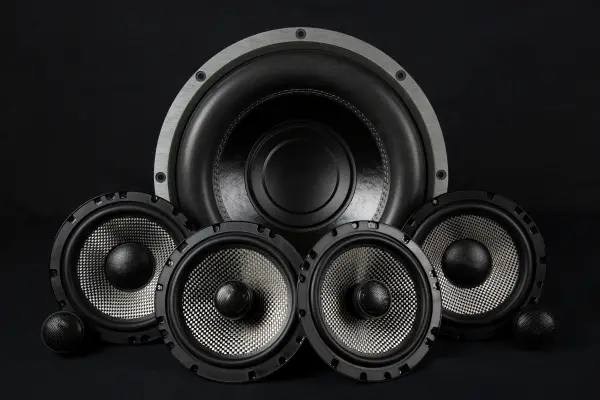What is a Subwoofer?
Welcome to the world of immersive sound and powerful bass – the realm where the subwoofer is king.
What is a subwoofer? Well, is a specialized type of loudspeaker that is specifically designed to reproduce the lower spectrum of sound frequencies, often referred to as bass. These are frequencies that typically range from 20 to 200 hertz.
While your average speaker can play these frequencies to a degree, a subwoofer is unique in its ability to deliver them with greater clarity and impact, thus making the overall sound richer, fuller, and more realistic.
Subwoofers play a critical role in both professional, home and car sound systems. In a cinema or concert venue, they contribute to the creation of sound effects that can be felt as well as heard, enhancing the audience’s immersive experience.
At home, whether you’re listening to music, watching a movie, or playing video games, a subwoofer can take your listening experience to a new level by adding depth and realism to the sound.
In a car, a subwoofer significantly improves the overall audio quality by delivering powerful and accurate bass, essential for making music more enjoyable during your rides. It helps overcome the ambient noise inherent in the driving experience and turns your vehicle into a moving concert hall, enriching even the simplest journeys with a high-quality sound experience.
Without a subwoofer, a sound system will lack the depth and fullness that only low-frequency sounds can provide. Imagine watching a movie without feeling the roar of an explosion, or listening to a song without the soul-stirring beats of the drum – that’s what a sound system without a subwoofer would feel like.
Whether you’re an audiophile looking to upgrade your home theater or car system or simply curious about how sound is produced, this article will offer a comprehensive guide to understanding what a subwoofer is.
>>Looking for a Powered Subwoofer?<<
The History of Subwoofers
Understanding what is a subwoofer takes us back to the early 1960s. The desire for deeper and more powerful bass was the key driving force behind its creation. El Cerrito-based company Electro-Voice was the first to commercially use the term ‘subwoofer’ in 1964 when they released a speaker system called the “Automatic Regulated Transducer”.
But it wasn’t until 1966 when Bill Kreutzmann, the drummer of the iconic band Grateful Dead, felt the need for a system that could produce low-frequency sounds more effectively for their live shows.
This need led to the birth of ‘The Wall of Sound’ – an enormous public address system designed by audio engineer and band’s soundman, Owsley “Bear” Stanley. This system was groundbreaking as it was one of the first to use separate signal paths for different frequency bands, including a signal path dedicated for bass.

Over the years, subwoofers have seen a number of significant advancements and refinements. In the late 1970s and early 1980s, home cinema and surround sound popularized subwoofers in household settings. This led to the development of smaller, more compact subwoofers that could easily fit in living rooms.
The 1990s and 2000s saw the advent of active (or powered) subwoofers, which have built-in amplifiers and offer more control over the sound produced. This period also marked the rise of subwoofers in car audio systems, a trend that continues to be popular today.
The digital revolution of the 21st century introduced sophisticated calibration systems and advanced design technologies, leading to the creation of subwoofers that can deliver high-precision sound in a variety of environments.
How Does a Subwoofer Work?
A subwoofer is a marvel of acoustic engineering, and to truly appreciate its function, it’s important to understand the basic principles of sound and the key components that make a subwoofer work.
1. Understanding Sound: Sound travels in waves through the air and is measured in frequency. Lower frequencies, which fall between 20Hz and 200Hz, are what we typically perceive as bass. These low frequencies are more felt than heard, like the rumble of a passing truck or the thump of a kick drum in a song.
2. Key Components of a Subwoofer: A subwoofer comprises three main parts – a speaker driver, an enclosure (box), and often an amplifier.
– Speaker Driver: The driver, or the woofer, is the heart of a subwoofer. It is a type of loudspeaker that produces sound in response to an electrical audio signal input. When the signal is applied, it causes the driver’s cone to vibrate back and forth, pushing and pulling air to create sound waves.
– Enclosure: The enclosure or box houses the driver. The design and type of the enclosure impact the sound by directing and amplifying the sound waves produced by the driver. It helps control the vibration of the driver, and prevents the front and rear sound waves from interacting and causing distortion.
– Amplifier: The amplifier is used to boost the audio signal from the source, powering the driver to create sound. In active subwoofers, the amplifier is built-in, whereas passive subwoofers require an external amplifier.

The interplay of these components results in the production of low-frequency sounds that add depth and dimension to music and movies, offering listeners a more immersive experience.
In the next section, we’ll explore the different types of subwoofers available in the market and their specific characteristics and benefits.
Different Types of Subwoofers
The world of subwoofers is as varied as the sounds they produce. Depending on the design, purpose, and technology, there are several types of subwoofers available in the market. Let’s explore some of them.
Active (Powered) vs Passive Subwoofers:
– Active Subwoofers: Also known as powered subwoofers, these have an amplifier built into the enclosure. This design simplifies the setup process, reduces the clutter of additional equipment, and offers better control over the sound, as the amplifier and the driver are specifically designed to work together.
– Passive Subwoofers: These subwoofers require an external amplifier to operate. They are often used in professional or high-end audio setups, where more customization and control over the sound system are required.
Sealed vs Ported Subwoofer Enclosures:
– Sealed Enclosures: These are completely airtight and are known for providing accurate and tight bass. They are typically smaller and require more power than ported enclosures.
– Ported Enclosures: Also known as vented or bass reflex enclosures, these have one or more ports (holes) that allow air to move in and out. They are typically larger, more efficient, and deliver louder bass than sealed enclosures.
>>Take a look at our Subwoofer Reviews<<
Specialty Types:
– In-wall Subwoofers: These are designed to be installed into the wall to save floor space and achieve a clean, uncluttered look. They usually require professional installation.
– In-ceiling Subwoofers: Similar to in-wall models, these are designed to be installed in the ceiling. They’re a great choice for multi-room audio systems.
– Vehicle-specific Subwoofers: These are designed specifically for use in vehicles, with shapes and sizes tailored to fit into spaces like door panels, under seats, or in the trunk.
Choosing the right type of subwoofer depends on a variety of factors including the size of the room, the main usage (music, movies, gaming), your personal preferences, and budget.

The Role of a Subwoofer in a Sound System
What does a subwoofer do? It plays an integral role in a sound system by enriching the auditory experience. Its key function is to produce low-frequency sounds (bass) that other speakers in the system may not effectively reproduce.
Enhancing the Depth of Sound:
The human ear can hear frequencies ranging from 20 Hz to 20,000 Hz. While most speakers are capable of producing sounds across this entire range, they often struggle with the lower end of the spectrum.
Here is where a subwoofer comes into play. By focusing on frequencies typically below 200 Hz, a subwoofer can produce a deep, rich bass that adds a fuller, more immersive quality to the overall sound.
Offloading the Work from Other Speakers:
When a subwoofer is added to the system, it takes over the job of producing the lower frequencies. This allows the other speakers in the system to focus on mid and high-frequency sounds, reducing distortion and improving overall sound clarity.
Immersive Audio Experience:
In cinema, the low-frequency effects channel (LFE) in 5.1 and 7.1 surround sound systems is specifically designed for a subwoofer. This channel adds depth to the audio and produces a rumbling effect that allows viewers to “feel” the sound, enhancing the cinematic experience and bringing the action scenes to life.
Improving the Music Listening Experience:
In music, a subwoofer helps in bringing out the rhythm and ‘feel’ of the music, especially in genres like EDM, hip-hop, and heavy metal that heavily rely on low-frequency sounds.
Enhancing Gaming Experiences:
For gamers, a subwoofer can provide a more immersive experience by accurately reproducing the low-frequency sounds of explosions or engine roars in video games.
How to Choose a Subwoofer
Choosing a subwoofer can seem like a daunting task, given the plethora of options available. However, by focusing on a few key aspects, you can find a subwoofer that is perfectly suited to your needs.
1. Consider Your Requirements:
- Room Size: A larger room may require a larger subwoofer or even multiple subwoofers to fill the space with sound effectively. Compact subwoofers may be more suitable for smaller rooms or desktop setups.
- Main Usage: If you primarily listen to music, a smaller, more responsive subwoofer may suffice. If you’re setting up a home theater system or enjoy action-packed video games, you might want a larger subwoofer capable of delivering powerful, room-filling bass.
- Vehicle Integration: If you’re looking for a subwoofer for your car, consider vehicle-specific models designed to fit in space-constrained areas.
- Budget: Determine your budget upfront. While high-end models offer advanced features and superior performance, there are many affordable options that deliver great sound quality.

2. Understand Technical Specifications:
- Power: Measured in RMS watts, this indicates how loud a subwoofer can play. Higher power handling is especially important in larger rooms or if you like to crank up the volume.
- Impedance: Measured in ohms, this refers to the resistance offered by the subwoofer to the flow of electrical current. Most home audio subwoofers are 8-ohm, while car subwoofers can be 2-ohm or 4-ohm. Make sure the impedance of your subwoofer matches that of your amplifier for best performance.
- Sensitivity: This indicates how efficiently a subwoofer converts power into sound. A higher sensitivity rating means the subwoofer can produce the same volume with less power.
3. Check Brand Reputation and Customer Reviews:
Brand reputation can be a good indicator of quality. Established brands tend to offer reliable products and good customer support. Also, check out customer reviews to get real-world insights into a product’s performance and reliability.
Finally, remember that the best subwoofer is not necessarily the one with the highest power or the largest size. It’s the one that best fits your room, matches your listening preferences, and works well with the rest of your sound system. With careful consideration of the factors mentioned above, you should be well on your way to choosing the perfect subwoofer for your needs.
Subwoofer Placement and Calibration
Optimal subwoofer placement and proper calibration are crucial steps to ensure the best sound quality from your subwoofer.
1. Subwoofer Placement:
– Home: For home use, placement often depends on room acoustics, available space, and personal preference. As a general rule, placing a subwoofer in the corner of a room can amplify the bass, making it sound louder. For a more accurate bass response, you might want to position the subwoofer along the front wall, near your front speakers. If you have multiple subwoofers, spreading them out can help even out the bass across a wider listening area.
– Vehicle: In a vehicle, trunk placement is common for traditional subwoofers as it maximizes bass output and minimizes vibration. For a more balanced sound, under-seat or door panel installations might be preferable. Vehicle-specific subwoofers often come with manufacturer recommendations for placement.
Remember, every room and vehicle is unique, so it’s important to experiment with different positions to find what works best in your particular situation.
2. Subwoofer Calibration:
Once you’ve decided on placement, calibration is the next step. Calibration is the process of balancing the sound from your subwoofer with the rest of your speakers.
– Manual Calibration: You can adjust the volume (or gain) and the crossover frequency on your subwoofer manually. The volume should be set to blend in with your main speakers, not overpower them. The crossover frequency is the point where your subwoofer will start producing sound in relation to your other speakers. This typically falls between 80 Hz and 120 Hz for home theater setups.
– Auto Calibration: Many modern home theater receivers offer auto-calibration features, using a microphone and a series of test tones to automatically adjust speaker levels and distances.
– Professional Calibration: For complex systems or for the best possible sound, professional calibration might be a worthwhile investment. Professionals have the tools and experience to fine-tune your system to its optimal performance.
Correct placement and calibration of your subwoofer can make a significant difference in the overall sound quality of your system, providing a richer and more balanced listening experience.
>>Take a look at our Subwoofer Reviews<<
What is a Subwoofer?
What is a subwoofer? A subwoofer is a crucial component of a sound system. Its ability to reproduce low-frequency sounds adds depth, power, and realism to music, movies, and video games.
From the simple desire to enhance the auditory experience, subwoofers have evolved considerably since their conception in the 1960s, becoming an indispensable element in both domestic and professional audio setups.
Choosing the right subwoofer involves considering factors like room size, main usage, budget, and understanding some key technical specifications. And, correct placement and breaking it in are vital steps to unlock the full potential of a subwoofer and achieve the best sound experience.
Whether you’re a movie buff wanting to bring cinema-like audio into your living room, a music lover aiming to feel every beat of your favorite songs, or a gamer looking to immerse yourself completely in virtual worlds, adding a subwoofer to your sound system can significantly enhance your listening experience.

I am a passionate and skilled car audio enthusiast with 15 years of experience in the industry. My journey started when I replaced my first set of factory car speakers, sparking a deep love for high-quality sound. Since then, I have worked as a representative for renowned brands like Kenwood and Alpine.
With a background in both retail and distribution, I have developed a comprehensive understanding of the car audio market. Currently a certified (MECP) installer in the Mobile Electronics industry, my expertise lies in delivering top-notch audio installations. My knowledge, coupled with my genuine passion, makes me the go-to professional for all car audio needs.

